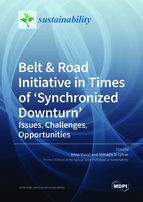Belt & Road Initiative in Times of ‘Synchronized Downturn’: Issues, Challenges, Opportunities
A special issue of Sustainability (ISSN 2071-1050).
Deadline for manuscript submissions: closed (30 October 2021) | Viewed by 28627
Special Issue Editors
2. Effat College of Business, Effat University, Jeddah, Saudi Arabia
Interests: smart cities; migration; innovation networks; international business; political economy; economic integration; politics; EU; Central Europe; China
Special Issues, Collections and Topics in MDPI journals
Interests: cognitive computing; artificial intelligence; data science; bioinformatics; innovation; big data research; data mining; emerging technologies; information systems; technology driven innovation; knowledge management; semantic web
Special Issues, Collections and Topics in MDPI journals
Special Issue Information
Dear Colleagues,
The launch of the Belt and Road Initiative (BRI) in 2013 triggered questions among experts and academics. Symptomatically, very little information about the initiative was available at that time, and so a sense of confusion was induced in the debate on BRI scope as well as its potential influence on all stakeholders involved. Connotations with the historical Silk Road had infused the debate on BRI not only with great expectations and hopes, but also with fears. Clearly, considering that China epitomizes export-led growth model, many observers argued that BRI might be just another way of facilitating Chinese exports. Also, caution has been recommended as regards the modes of financing BRI-related projects with regard to sustainable financing, potential indebtedness, and management of debt problems in borrower countries (Hurley, Morris, & Portelance, 2018). In the same context, implications for Southeast Asian regional architecture and the prospect of Sinicization have been stressed (Suehiro, 2017).
Six years into the official start of BRI, an understanding of what the initiative’s objectives are consolidates. This is reflected in academic research and more policy-oriented publications stemming from the think-tank sector (Albert, 2018; Gabuev, 2016; Jakóbowski & Kaczmarski, 2017; Visvizi et al., 2019). Notably, there is a growing recognition on the part of international organizations, such as the World Bank Group (WB), and other key players on the international scene, such as the International Chamber of Commerce (ICC), to mention just these two, that serious consideration should be given to BRI and its implications. At the same time, developments on the ground suggest that in as much as BRI embodies a bold vision of the future, it is also beset, like the original Silk Road, by a variety of contingencies and constraints (Blanchard & Flint, 2017; Kozłowski, 2018).
Current developments pertinent to international trade, including trade wars, unstable political and economic environment, military conflicts, and the prospect of ‘synchronized slow-down’ (Georgieva, 2019) place BRI and its dynamics in a new context. The objective of this Special Issue is to examine the broadly defined implications thereof from a variety of disciplinary perspectives. The intention of the Guest Editors is to encourage and streamline conceptually sound and empirically grounded research on BRI, thereby making this Special Issue a reference for the broad community of researchers, academics, and practitioners.
The Editors of the Special Issue welcome papers that address, but are not limited to, the following issues and topics.
Examples of topics of interest include:
- BRI and contemporary business environment: issues, developments, implications;
- BRI and sustainability: climate, resources, society;
- BRI and domestic/international regulatory frameworks;
- BRI and the business sector: B2B, BMI, HRM;
- BRI and infrastructure: transportation, electricity, networks;
- BRI and sophisticated information and communication technology (ICT): from distributed information systems to AI and their application;
- BRI and smart cities: an insight into the role of (smart) cities in building competitive advantage along BRI;
- BRI and the Arab Peninsula: insights into regional developments;
- BRI and regional collaboration schemes: from ad hoc collaboration to strategic alliances;
- BRI and innovativeness: R&D, innovation policies, strategies, approaches, comparative insights;
- BRI and international organizations: rethinking multilateralism;
- BRI: case studies, prototypes and project deliverables related to OBOR;
- Covid-19 inflicted implications.
Prof. Dr. Anna Visvizi
Prof. Miltiadis D. Lytras
Guest Editors
Manuscript Submission Information
Manuscripts should be submitted online at www.mdpi.com by registering and logging in to this website. Once you are registered, click here to go to the submission form. Manuscripts can be submitted until the deadline. All submissions that pass pre-check are peer-reviewed. Accepted papers will be published continuously in the journal (as soon as accepted) and will be listed together on the special issue website. Research articles, review articles as well as short communications are invited. For planned papers, a title and short abstract (about 100 words) can be sent to the Editorial Office for announcement on this website.
Submitted manuscripts should not have been published previously, nor be under consideration for publication elsewhere (except conference proceedings papers). All manuscripts are thoroughly refereed through a single-blind peer-review process. A guide for authors and other relevant information for submission of manuscripts is available on the Instructions for Authors page. Sustainability is an international peer-reviewed open access semimonthly journal published by MDPI.
Please visit the Instructions for Authors page before submitting a manuscript. The Article Processing Charge (APC) for publication in this open access journal is 2400 CHF (Swiss Francs). Submitted papers should be well formatted and use good English. Authors may use MDPI's English editing service prior to publication or during author revisions.
Keywords
- Belt & Road Initiative
- International/global collaboration
- International business
- Sustainability: Climate, resources, society
- competitiveness & innovativeness
- Global business management
- Business model innovation
- Policy-making
- Sustainable development
- European Union
- China
- FDI
- Smart cities
- Big data
- Analytics







